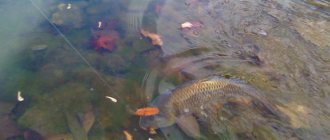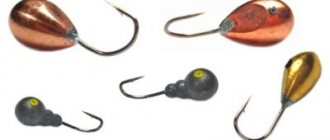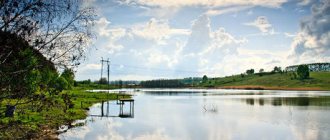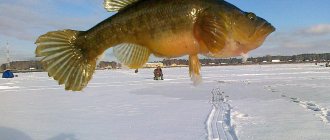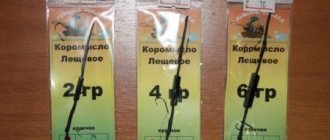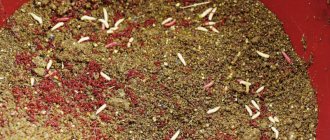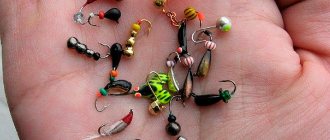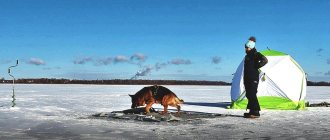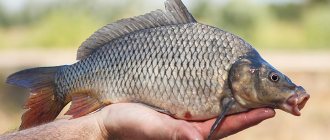Winter ice hunting for carp has been practiced by fishermen not so long ago. It is difficult to catch such large fish. This is partly true, since this representative becomes extremely capricious when it gets cold and stops feeding. Therefore, only knowing how to catch carp in winter can you go after the coveted prey.
Catch on ice
How to find carp in winter
When going on a search, you need to take into account the temperature of the aquatic environment. This fish likes to settle where it is warmer (at the bottom). Despite the fact that under the ice crust there is the warmest layer (0 degrees), carp rarely rise so high. And given the importance of oxygen for a predator, it must be found where there is plenty of it. Such places include:
- dams;
- dams;
- rivers (former ravines);
- shallow water in ponds where there is a lot of vegetation, snags and deep holes;
- areas where warm streams constantly flow.
For beginners in this business, it is better to explore the reservoir in the summer, ask local fishermen and find out where the bite is best. Promising places in summer remain the same in winter. An echo sounder will make searching for prey easier.
We must not lose sight of the behavioral characteristics of fish with the onset of cold weather. She is characterized by a violent temperament, which often leads to damage to the gear. But this only happens in the summer. In winter, the predator falls into an ambitious state, although it does not stop feeding. Therefore, you need to choose good gear and everything else.
Tackle and fishing methods
Unlike other, smaller inhabitants of reservoirs, carp strongly resists when fished. Not every tackle can withstand such pressure - it must be strong and moderately rough. Otherwise, it will become too noticeable, which will reduce the number of bites.
Fishing rods - fishing with a jig or spinner
Types of winter fishing rods
There are 2 types of fishing rods suitable for fishing: Balalaikas - their reel also serves as a handle. An option suitable for catching small carp using a jig. This type of gear is easier to maneuver.
Classic - float fishing rods with a handle, which are used when hunting for large game. Jigs are also used. They are more suitable for fishing in large ponds, where trophies weighing up to 3 kg are common. Unlike balalaikas, they are equipped with a volumetric coil. This prevents the rod from being pulled into the hole.
The length of the whip is selected depending on the fishing method - standing or sitting. Size 40-100 cm.
When catching carp from ice, fishermen use jigs - they go better with a nod. If hooks are used, then it is advisable to combine them with a spoon and a sinker. Both options are working.
Nod
It is better to take long nods
Since in winter carp are caught without playing as actively with a jig as in the case of perch, the nod serves more to signal a bite. Therefore, when selecting, we focus on the following characteristics:
- Length - within 15-20 cm.
- Material: lavsan or flat metal spring.
- The color is bright, attracting the attention of fish from afar.
- The nod must be attached to the rod whip using a rubber clamp.
Fishing with a float rod
Any floats are suitable for winter carp fishing.
If a float is used as a signaling device, it must be large. When the water temperature is slightly below zero, preference is given to small-sized “wagglers” or two-piece floats for winter fishing.
In the dead of winter, it is better to use floats in the form of tablets. When the weather is consistently warm and the ice is slightly melting, large sliding floats 50 cm long are used.
Since they are caught mainly in the bottom layers, the color of the floats is not so important - in cloudy water, the fish still will not notice what is looming from above at a distance of 5 meters. The top of the alarm, which has a rich scarlet or dark green color, is slightly submerged relative to the water surface by 2 cm. This prevents it from freezing into the ice.
Fishing with a float rod is considered a classic method, requiring a certain patience and control over the tackle. The method is suitable for both active and passive carp. For fishing at night, large floats are used, and the bait is corn with bloodworms or worms with maggots.
fishing line
When fishing for carp in winter, use monofilament or braided fishing line. Monofilament with a diameter of 0.12-0.22 mm is good for fishing for small fish. For larger representatives, scaffolding with a cross section of 0.2 to 0.3 mm will be required. Braided, diameter should be 0.06 to 0.12 mm.
When using thickened monofilament line, they try to choose a color so that it is not very noticeable in the water. These are dark colors.
Carp jig
Allows you to smoothly maneuver the bait, shaking it periodically. A similar game is acceptable for catching sluggish carp - it can provoke it. Slow rises and descents of the jig near the bottom also help. If the fish does not bite, but discovers itself by touching it, you need to freeze for a while or make slight oscillatory movements when retrieving.
Jigs
Successfully bites on standing jigs. You need to choose a smaller one, but with a large hook. It is important that the product not only reaches the bottom of the reservoir, but also stays there with the nozzle. In this regard, jigs like:
- pellet;
- oatmeal;
- a drop.
The color of this element of gear does not matter. But fishermen more often buy black, rich green or dirty red. When fishing with jigs, the signal that the prey is hooked will be the swinging of the nod, followed by a jump or going under water.
Bait - fishing with corn and other baits
Carp react more actively to bait of animal origin:
- bloodworm;
- earthworms;
- maggot.
The bite on vegetable baits is a little worse: corn, porridge, peas. Many fishermen combine livestock with plant lures (for example, adding a couple of bloodworms or maggots to a corn grain).
Fishing with girders
Fishing for a zherlitsa can give good results at the beginning of winter (on the first ice). During this period, carp still continue to actively search for food, so they live mainly closer to the surface. In early spring, you can also use the girder, since the fish begins to rise - they begin their pre-spawning feast.
A zerlitsa is a tackle in the form of a reel and a signal flag
Experienced fishermen manage to catch carp on a girder even in the dead of winter. Carp constantly changes its location. If there is no bite on one hole for 1-2 hours, you need to move to another.
Carp in December on the feeder
Reservoirs are not covered with ice at the same time, and in the southern regions, on large and medium-sized rivers, carp fishing continues in December in open water. Open water fishing is done from the shore and boat. All summer gear is applicable: feeder, float rod, etc.
The most successful carp fishing is in December on the feeder. It is important to correctly identify promising fishing spots. Signs of promising places:
• Landfills in the bottom relief. It must be taken into account that the carp does not look for food at the very bottom of the discovered holes. It descends to depth after saturation. Feeding and casting should be done on ledges in dumps or on exits from pits. In December, carp bites can be expected at a depth of 2-3 meters;
• Areas on the borders of bottom vegetation;
• Boundaries between muddy and hard bottoms;
• Bottom springs;
• Confluence of tributaries or places of artificial discharge of clean water;
• Steep banks. In such areas, you can also use a float rod.
When feeder fishing in cold water, there is no need for additional bait. To attract fish, the complementary food that fills the feeder is sufficient. Although this is a controversial issue, and there are many supporters of feeding carp in December with low-calorie bait, the inedible part of which is 50 percent or more.
To fill the feeder, use purchased bait plasticine for carp fish or use mixtures prepared by yourself. Each fisherman chooses the composition based on personal experience. Practical fishing shows that carp are well attracted to crushed cake, boiled peas and corn, as well as various cereals. A small amount of chopped worms, small bloodworms or maggots is added to the mixture.
Composition of carp bait
Complementary feeding is important both in summer and winter. Necessary for luring fish closer to the hole in the ice. Only in winter it is not so voracious and requires less food to satisfy itself. Therefore, you should not overdo it, otherwise the predator will quickly eat enough and stop pecking altogether.
Carps love to eat, so fishermen call them “piglets”
The bait can be ready-made (sold in specialized stores) or homemade. In the first case, compositions for catching crucian carp or crucian carp are selected. The composition of mixtures prepared independently usually includes the following components:
- millet (it is not fully cooked);
- powdered milk;
- crushed roasted peanuts;
- bran (preferably rye).
You cannot add any flavorings to complementary foods - they will only scare off prey that has a developed sense of smell.
The attractive mixture is flavored with a small amount of water from the pond. When it swells, roll it into balls and throw it into the hole. Then feed bloodworms are poured in there (literally a pinch).
Fishing technique - hooking and retrieving
When catching, you need a special technique. It is important not to miss the moment when a bite occurs and immediately make a hook. After this, you need to competently pull the fish out (the process is called reeling).
When there is a bite, the upper part of the float is activated
When fishing with a float tackle, when a fish is caught, the signaling device begins to twitch slightly and rise in the hole. If a nod is used, the float first begins to tremble and straightens sharply. Sometimes the alarm sinks instantly and the nod bends (this happens with small fish).
When catching carp with a jig, the main thing is to make the hook in a timely manner. It should be short and sharp, immediately after straightening the nod or when raising the alarm above the water. Here it is unacceptable to swing too much or hesitate - in the first case, the hook can tear the lip and it will break, in the second, the jig will jump out of the fish’s mouth.
Small and medium-sized ones are caught quickly. If you come across more impressive prey, you should pull it towards the hole carefully, without forcing events. At the same time, carefully collect the fishing line and throw it aside so that it does not interfere with the process.
When faced with serious resistance, they clamp the line with two fingers and cast it under pressure - a few passes like this and the fish will run out of steam. Then the carp's head is inserted into the hole and pulled onto the ice using a hook.
Baits and lures
For carp hunting to be productive, you need to prepare and feed the holes. Working food for carp, according to the advice of experienced fishermen, consists of 90% inedible (low-calorie) ingredients, and 10% edible. You should not use flavorings, just add a little bloodworm. Such bait will perfectly attract fish to the hole without saturating it. No more than three hundred grams are thrown into the hole per day.
Read! The best live bait for winter fishing
The feed mixture can be either finely or coarsely fractionated, used raw (compound feed used in fish farms) and boiled. Each fisherman has his own secret recipe for making it.
Catching baits and attachments are: dung worms, bloodworms, insect larvae, boilies, pearl barley and wheat grains.
What time to catch
The period of successful fishing on a pond depends on the degree of ice cover, as well as weather conditions and time of day. In winter, and even at night, you should not hope to catch this predator. Even during the day he doesn’t come out for long, so you need to have time to provoke him to bite.
First ice - December
Fishing in December guarantees success. Under the ice that has not yet formed, the carp continues to feed as before. They go hunting from early morning until 3 o'clock in the afternoon. Therefore, every avid fisherman looks forward to the freeze-up period.
Glukhozimye - January
Carp becomes passive in the dead of winter. No more than half an hour is enough for saturation - during this time the fish come out of their hiding places. Such “outings” occur more often after lunch. They note an improvement in the bite on cloudy days with light snowfall. But in cold weather, with a sharp drop in atmospheric pressure or strong wind, the fish stop eating.
Last Ice - February
In February it comes to life - prepares for spawning and begins to feed intensively again. At this time, the fish reacts to any bait. In sunny and warm weather, the bite can last up to 5 hours.
Winter carp sites
Oddly enough, you need to look for carp in winter in the same areas of the reservoir as in hot summer . And if in the heat the fish finds life-giving coolness there, then in winter in such places the water remains warmer.
In addition, the food supply at such points is the richest. Not only holes and depressions in which winter carp stand can be promising for fishing. The nearby entrances and exits from the dumps and whirlpools will also be interesting places.
- In an unfamiliar body of water, you should look for carp not only in the deepest depressions. Fish occupy such water areas where they are not only comfortable to be, but also safe. Steep slopes and snags, sunken boats or fallen bridges become good options for winter carp parking. And if the depth in such places exceeds 2 m, then prey can be found here with a high probability.
- During warm and calm weather, which is accompanied by increasing atmospheric pressure, carp may come to the shallows to feed. And if weather conditions remain constant for two days or more, then it is possible to catch large fish at a depth of 0.5-1 m.
- Winter carp are also attracted to areas of the reservoir into which warm water penetrates. These can be the confluence of non-freezing streams, springs, sections of the river below power plants, etc. In addition to warm water, in such water areas there is also a richer oxygen regime, which activates carp.
- Experienced fishermen advise looking for freshwater “piglet” among dead lilies, in reeds, and also on the leeward side of the lake.
Fishing tricks - tips from experienced carp anglers
A larger hole is clearly needed
In addition to the standard rules of conduct when fishing from ice, there are several more subtleties that affect the effectiveness of the process. Here are some pro tips:
- at the beginning of winter, when the ice is still thin and carp are scurrying near the surface, shade the hole with snow (cardboard or whatever is at hand) or do not completely remove the ice crumbs;
- to drill holes in the ice, use an ice ax with a diameter of more than 130 mm - otherwise, when fishing, a large fish will not slip through the small hole;
- if the bite decreases, add more feeding in combination with bloodworms;
- When the fish does not bite or repeatedly leaves the hook, check the sharpness and also replace the line with a smaller diameter one.
- Experienced fishermen recommend making several holes. This is in case there is no bite for a long time. Then you can quickly move to another hole and try your luck again.
Fishing for carp from ice
Videos about successful winter carp fishing are increasingly appearing on the Internet, and the number of skeptical winter fishermen is approaching zero. The most promising is carp fishing in December from the ice on the first ice, and with the arrival of spring on the last ice.
As soon as the reservoirs are covered with safe ice for fishing, carp anglers go on exciting ice fishing for carp. But you should not count on a quick bite from this fish. In the short December days, the main thing is to choose a fishing spot as quickly as possible. The search is simplified at a fishing base in an artificially stocked pond, and this task becomes more difficult in an unfamiliar body of water.
In any case, when choosing places, you will have to drill a considerable number of holes. The signs of promising places are the same as when fishing in open, but cold water.
Fishing for carp in December with a winter fishing rod involves frequent movements to new areas. It is important to pay attention to equipment. Clothing should be comfortable, warm and not restrict movement. It is better to wear several warm clothes than one fur sheepskin coat. In addition, you should choose a well-sharpened fishing ice screw (diameter 10-20 cm), and provide an ice pick to widen the hole. To extract large fish onto the ice surface, you must use a hook.

